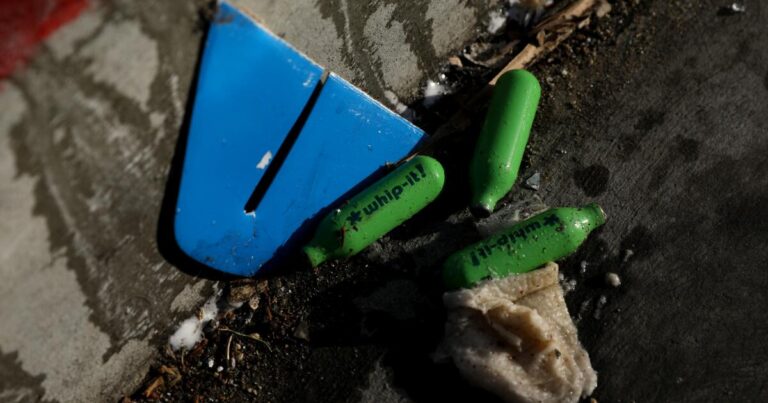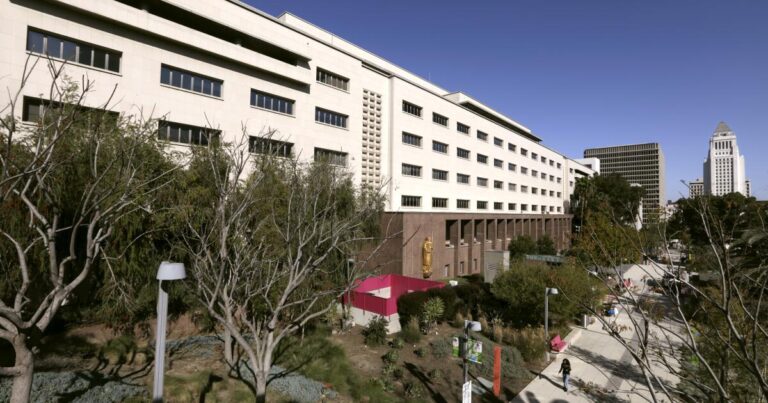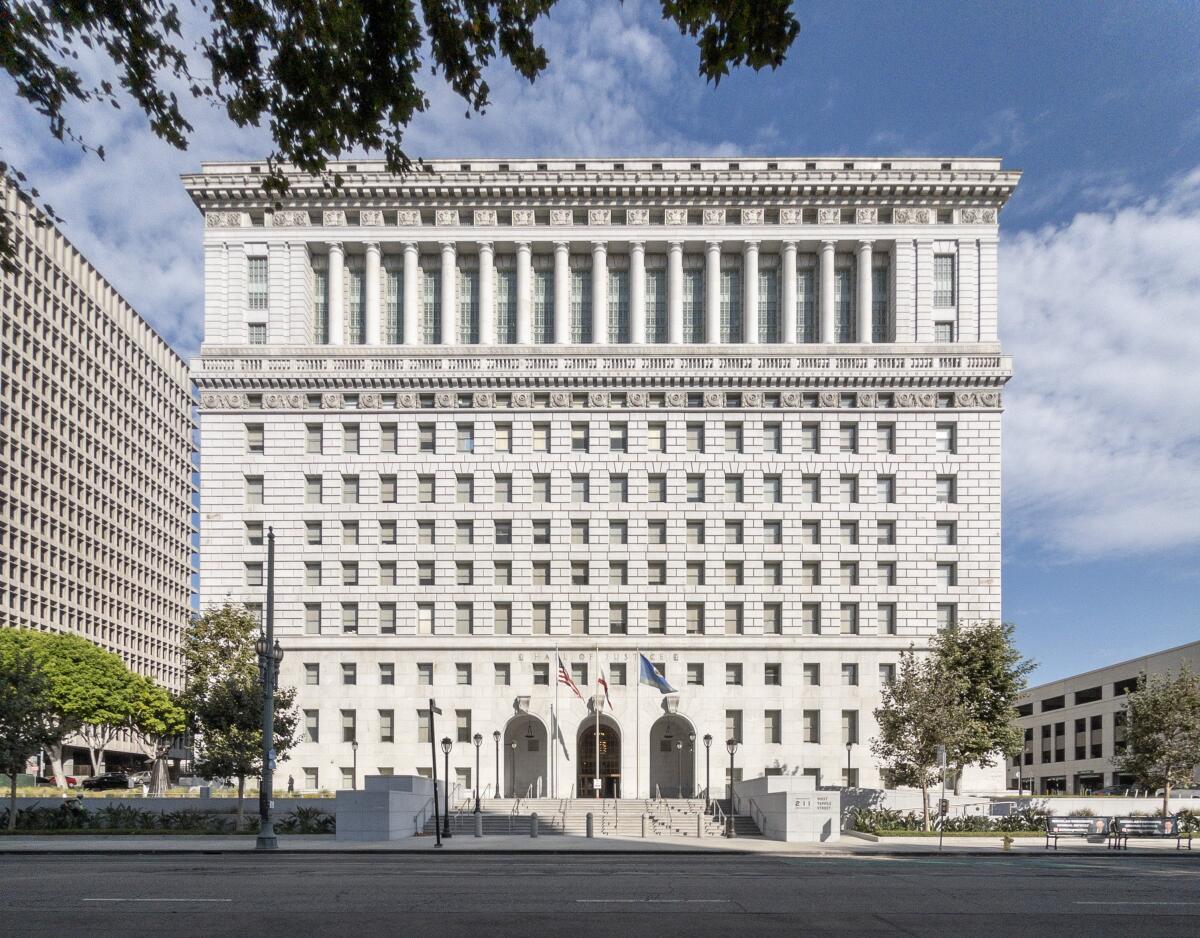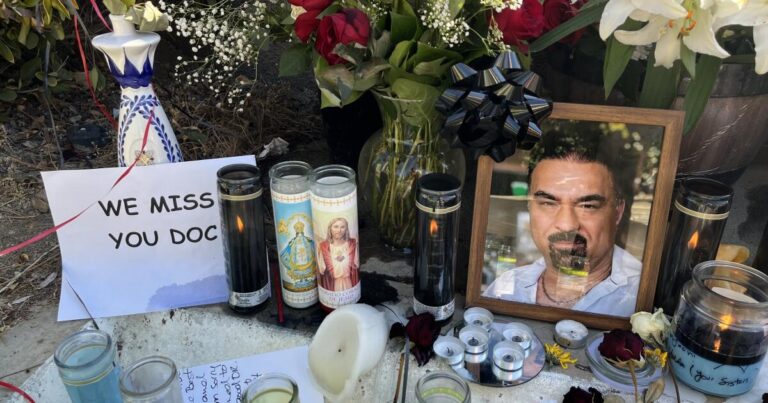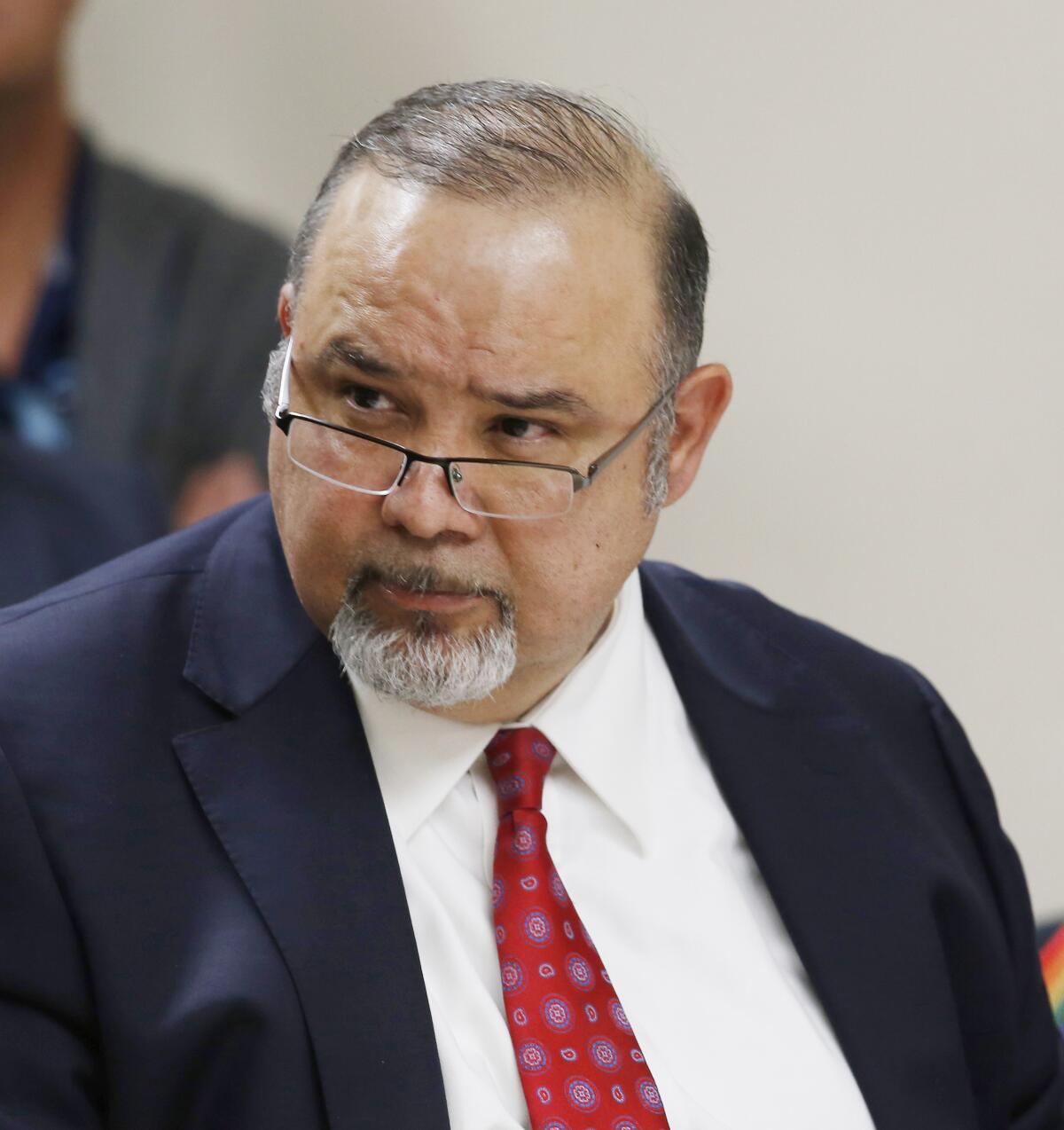It was an ordinary day at his Los Angeles law office when John Nadolenco opened a letter from Brazil enlisting his help in a mission to retrieve a stolen, and quite possibly cursed, 836-pound emerald.
The year was 2014, the heyday of the Nigerian prince email scam, and the up-and-coming attorney was no fool.
“I immediately thought it was just completely fake, a total hoax,” he said. “I was like, ‘I’m not falling for this one. I’m smarter than this.’”
He tossed the letter in the trash.
But Nadolenco’s boss asked if, as a favor, he could look into the Indiana Jones-esque request to reclaim the Bahia Emerald. So Nadolenco skeptically reached out to a colleague in his firm’s Brazil office.

The Bahia Emerald is an 836-pound behemoth that has been the subject of a court battle among a colorful crowd of gem traders, miners and businessmen vying for the prized jewel.
(Los Angeles County Sheriff’s Department)
He was flabbergasted to learn that not only was the Bahia Emerald real, but the Brazilian government was genuinely interested in using his legal skills to retrieve the gem, which was being held in the Los Angeles County Sheriff’s Department’s custody amid lawsuits over its ownership.
The emerald had been plucked from a mine in the Carnaíba mountain range, located in the Bahia region of northeastern Brazil.
“Bahia Emerald” is a misnomer because it is not one gem but nine dazzling crystals encased in a rough black rock 30 inches wide and 33 inches high. Each crystal is as thick as a Coke bottle, and one is believed to be the largest single emerald ever found.
But how did the stone, which weighs about as much as a full-grown bison, end up in L.A. County? And how could Brazil get it back? It was Nadolenco’s mission to find out.
The stone, he learned, was smuggled to the U.S. in 2005, and a series of lamentable tales — some fact, some fiction — have followed those who claim to own it, giving rise to the belief that the emerald is cursed.
A Bay Area building contractor swore his house burned to the ground (true) with his deed of ownership inside (likely false). Investors in a failed tech startup almost lost the gem to the flooding of Hurricane Katrina (true). A Northern California plumber claimed he was kidnapped by Brazilian warlords while owning the emerald (false).
The value of emeralds in general is highly variable and often set at whatever a buyer is willing to pay; appraisals of the Bahia Emerald have ranged from a couple thousand dollars to a jaw-dropping $925 million. Its value is especially tough to pin down due to its sheer size and one-of-a-kind nature.
“Our final valuation is that we would never sell it because it’s priceless for us,” said Fernando Filgueiras de Araujo, a federal attorney in Brazil’s foreign disputes unit.
Despite the many hands grasping to own it, few people have ever laid eyes on it. No one in the Brazilian government has seen the emerald in person, nor has Nadolenco.
One of the few who have seen the stone is Scott Miller, a now-retired Los Angeles County Sheriff’s Department detective, who seized the emerald from a Las Vegas warehouse in 2008.

Major Crimes Dets. Scott Miller, left, and Mark Gayman of the Los Angeles County Sheriff’s Department pose with the Bahia Emerald, which they seized from a Las Vegas storage center on Dec. 19, 2008. Miller has since retired.
(Scott Miller / Los Angeles County Sheriff’s Department)
“It wasn’t as pretty as the pictures,” Miller said. “It was this large black rock, almost like a lava rock. But it did have the huge spires of emerald coming out of it, which was really cool to see.”
The men responsible for starting the mythology surrounding the Bahia Emerald are Elson Alves Ribeiro and Rui Saraiva Filho, the two Brazilians who took possession of the stone after it was pulled from a mine in 2001.
What happened to the rock for the next 23 years is the subject of controversy and confusion. The following timeline of the stone’s convoluted history is drawn from the facts laid out in a Los Angeles County Superior Court ruling over its ownership.
According to court documents, in September 2001, two friends from Northern California — mining consultant Kenneth Conetto and building contractor Anthony Thomas — flew to Brazil to purchase emeralds as part of a Hail Mary effort to save a failing tech start-up.
Thomas had sunk more than $200,000 into a digital imaging company, Digital Reflections Inc. (DRI), which was in dire financial condition and on the brink of shutting down.
The company learned of an investment opportunity that promised sky-high returns on a $100-million investment, and the following get-emeralds-get-rich plan was born:
Conetto, Thomas and DRI executive Wayne Catlett would secure $25 million worth of small cut and polished emeralds from Ribeiro and Filho. Then, they would use the stones as collateral for the $100-million loan needed to participate in the investment program.
The idea was to make quick money, pay Ribeiro and Filho over $3 million, save the failing company and live happily ever after.
Things did not go as planned.
For starters, no one from DRI had been able to assemble a loan that could use the cut emeralds as collateral by the time Conetto and Thomas arrived in Brazil in September 2001. During the trip, Ribeiro and Filho did, however, take the Americans to see the Bahia Emerald in storage.

The Bahia Emerald is not a single gem but consists of nine dazzling crystals encased in a rough black rock 30 inches wide and 33 inches high.
(Los Angeles County Sheriff’s Department)
A month later, Thomas wired $60,000 to Ribeiro — a fee that he said was to purchase the Bahia Emerald, but that court documents said was used to cover the cost of cutting and polishing the collection of emeralds the Brazilians had gathered for the DRI loan.
Thomas told the court that the Bahia Emerald mysteriously disappeared in transit to California and he suspected a corrupt Brazilian government was to blame, which is why he never bothered filing a theft report. When asked where his bill of sale was, Thomas said it burned up in a 2006 fire that destroyed his home in Morgan Hill.
Los Angeles County Superior Court Judge Michael Johnson ultimately ruled against his ownership claim, writing in a 2014 judgment, “Thomas’s testimony was like sand in the wind — constantly shifting and changing its shape.” Thomas filed for bankruptcy a few weeks later.
Thomas never ended up possessing the stone, which instead was sent from Brazil via FedEx to his friend-turned-rival Conetto in 2005.
Conetto then sent the stone from San Jose to a storage facility in New Orleans, where it was submerged for weeks after Hurricane Katrina flooded the city that year.
At the time, Conetto was still working with DRI staff and the two Brazilians to use the Bahia Emerald as collateral for a loan, but as time passed and no progress was made, the team decided to sell the emerald.
In order to do so, they enlisted the help of two additional colorful characters: a Northern California plumber called Larry Biegler and a Florida gem dealer called Jerry Ferrara. Both men would later join the legal fray, claiming they owned the emerald.
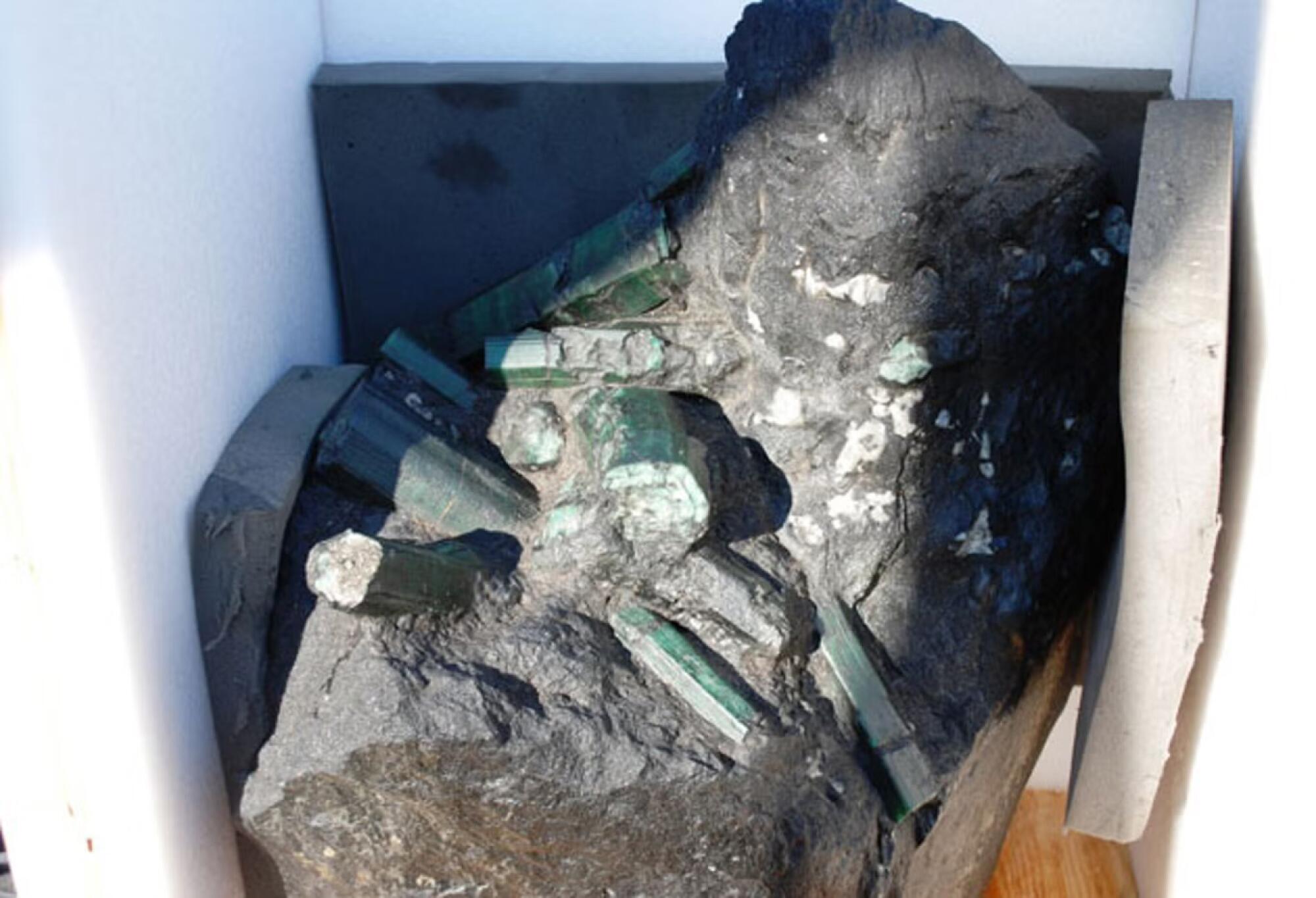
The value of the Bahia Emerald is the subject of great debate. The highest appraisal for the gem was a jaw-dropping $925 million. But others say it’s an ugly, mostly black rock likely worth thousands, not millions, of dollars.
(Los Angeles County Sheriff’s Department)
Biegler shipped the stone back to San Jose in August 2007 and unsuccessfully tried to secure a buyer. Biegler later told Ferarra that he’d been kidnapped by Brazilian warlords and asked him to send ransom money, according to reporting from Wired.
In April 2008, Ferrara decided to take over efforts to sell the stone and had it transported to a storage facility in El Monte.
Ferrara, too, struggled to find a buyer, but had no problem using the stone as collateral for an expensive diamond deal with Idaho businessman Kit Morrison.
Morrison paid $1.3 million upfront for the diamonds, but the deal fell through and he suddenly found himself the unintentional owner of an 836-pound emerald. With Ferrara’s help in September 2008, he moved the stone to Las Vegas.
Biegler was not happy about the disappearance of the precious emerald and reported the stone stolen from the El Monte storage facility.
This is where detectives from the Los Angeles County Sheriff’s Department enter the scene. Unable to determine who was the true owner of the stone, Miller and his colleague Mark Gayman decided to track it down and let the courts decide.
The pair traveled to Morrison’s home in snowy Idaho, where — after a threat to unwrap every present under his Christmas tree in pursuit of the gem — Morrison’s attorney informed them that the gem was in Las Vegas, Miller said.
So the detectives drove back to the Boise airport, landed in Los Angeles at 2 a.m., rendezvoused with co-workers at 4 a.m. and headed to meet Morrison at a high-security storage center in Las Vegas.
“He let us in and we opened up the crate and there was the emerald,” Miller said. “It took five of us to lift the crate into a van. We did some quick photographs for evidence and then drove in a caravan, fully armed all the way back to L.A.”
This was part of their heritage that had been stolen from Brazil. They felt wronged and they wanted it back.
— Attorney John Nadolenco on Brazilian efforts to reclaim the emerald
Soon afterward, a member of the U.S. Department of Customs and Border Protection contacted the Brazilian government to say the Sheriff’s Department was in possession of a massive Brazilian emerald.
The Los Angeles County Superior Court ownership battle over the stone began in 2009. This tussle was still ongoing five years later, when Nadolenco received the letter from the Brazilian government and embarked on a separate legal battle to repatriate the stone to Brazil through federal court.
Nadolenco remembers being extremely stressed when it appeared that the Los Angeles County Superior Court judge would rule on the gem’s ownership before Brazil could finish presenting its case.
To the Brazilians, “this wasn’t just a legal case,” Nadolenco said. “This was part of their heritage that had been stolen from Brazil. They felt wronged and they wanted it back.”
In June 2015, Judge Johnson ruled the stone did indeed have an owner: FM Holding Inc. “presented evidence establishing clear title to the Bahia Emerald.” This company was co-owned by Morrison, the Idaho businessman; his business partner Todd Armstrong; and Ferrara, the Florida gem trader.
But as seems to happen with the giant gem, there was a twist.
Just days before the stone was to be released, a federal court judge ordered that the emerald remain under lock and key until the federal case with Brazil concludes.
Meanwhile back in Brazil, government attorneys were accusing Filho and Ribeiro of illegally mining the gem and smuggling it out of the country.
After a lengthy trial and appeal process, the men were found guilty in 2017, but they never served jail time because of the statute of limitations surrounding their crime, said Filgueiras de Araujo, the federal attorney.
Nevertheless, their conviction allowed Brazil to invoke a mutual legal assistance treaty with the United States and ask the U.S. District Court for the District of Columbia to order the emerald’s forfeiture.
U.S. District Judge Reggie B. Walton approved the forfeiture motion on Nov. 21, asserting that American “interventors” have no right to the stone. The true owner, he declared, was Brazil.
If no appeal is filed, the next step will be to schedule a repatriation ceremony to turn the stone over to Brazilian officials, who plan to display it in a museum.
Nadolenco said he hopes to attend the ceremony, as he’s curious to finally make the gem’s acquaintance. He never asked to earlier because it wasn’t necessary to the legal case. But he’d like to see it now, with slight trepidation.
“I’d love to see it in person, but there’s a small part of me that may throw salt over my left shoulder or keep my fingers crossed behind my back, just in case,” he said.
In its travels around Brazil and America, the stone has wreaked havoc on the lives of smugglers, schemers and dreamers.
But retired detective Miller, one of the few people to have temporarily possessed the stone and suffered no dark twists of fate, sees no reason to fear the emerald.
“I believe that greed,” he said, “is the only curse that stone ever had.”


